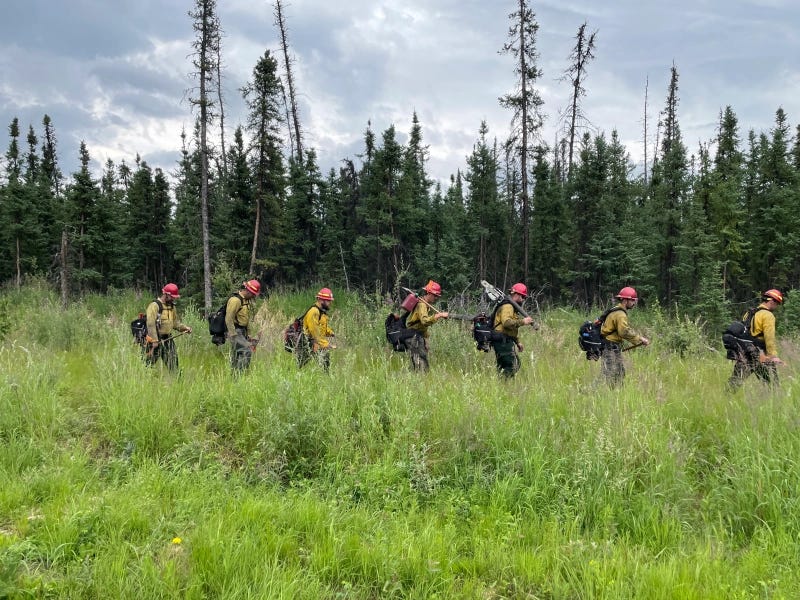(What is) PL4?
Fire season is officially underway. Let me help you understand it. Plus: wildfire updates
When I was revising my forthcoming book, Hotshot, I had to reverse engineer my experiences as a wildland firefighter, deconstructing them so the reader could understand how the job worked. But, you know. Not in a boring way. In a way that felt natural.
The jargon associated with wildland fire and firefighting can be a barrier to understanding, especially for the general public. This season, I’m determined to translate things for my readers, while also maintaining an ease of reading for those who already know what I’m talking about. But also: Read my book and you’ll learn a lot more.
So: What’s PL4?
Last week the national fire preparedness went from level 3 to 4. This is on a scale of 5. What does this mean? Here’s a handy chart:
Fires start all the time. House fires, grass fires, forest fires. Fires of all sorts. Local agencies respond without incident. But as fire season picks up and overwhelms local resources, federal resources are summoned.
This year’s season started in January 2025, when most federal resources weren’t even on the clock, with the fires in Los Angeles. Then, in early spring, fires popped up in the Southwest and Alaska (both normal places for early season, though there were abnormal east coast fires, too).
Each region’s individual preparedness level directly affects the national preparedness level. The federal government has limited resources (especially now, after many agencies lost employees to firing and layoffs), so when more than a few regions have reached a PL3 or higher, that collectively raises the national preparedness level. Each large incident (also measured on a scale from 1-5, with Type 1 fires being the largest) is assigned an Incident Management Team (IMT), as you can see in the above illustration. You may also notice that this is all incredibly complicated, which is why it’s so important that we protect federal response agencies from being dismantled.
TL;DR: There are a lot of large fires throughout the United States. And Canada, too. And Europe.

So, What’s the Situation?
I’ve collected these links for you and it takes a long time to do this. Please consider becoming a paid subscriber if you’d like to support this project. On Wednesday I’ll be sharing an excerpt of Hotshot’s cutting floor scraps to paying subscribers!
An important note: fires are a natural part of many ecosystems, and many of the fires listed below were caused by lightning.
Alaska’s been burning for a while, and the state remains at a preparedness level 4, despite a lot of progress made by thousands of firefighters.
The White Sage Fire (lightning caused) prompted evacuations and closures in and around Grand Canyon National Park. On Sunday the fire grew from 20,000 acres to 40,000, and destroyed an estimated 40-60 structures, including the historic Grand Canyon Lodge, which was built in 1932, although the original lodge was rebuilt in 1937, after being destroyed by a kitchen fire.
FEMA has released funds to help contain the Deer Creek Fire in San Juan County, Utah, which remains 0% contained and has forced local residents to evacuate.
The South Rim Fire in western Colorado’s Black Canyon of the Gunnison National Park has doubled in size over the weekend and remains uncontained. The National Park has been closed due to fire danger.
What do fires and floods have to do with one another? This article only scratches the surface. Let me know if you’d like to learn more by leaving me a comment.
A large swath of the Midwest is being affected by wildfire smoke from Canada. Some American politicians complained to Canada in an official letter.
Indigenous Canadians are being adversely affected by this summer’s wildfires, but aren’t receiving the help they need.
While our current federal administration fucks around, California just approved year-round funding for Cal Fire, their state wildland firefighting agency, and is coming close to passing a bill to raise pay for incarcerated firefighters.
Pre-order Hotshot and support a debut author.
My first book, Hotshot, debuts in less than a month(!). It’s received starred reviews from Kirkus and Publishers Weekly, plus a mention in the New York Times. I spent six years writing and researching Hotshot, which is both a memoir and a reported history of fire suppression in the United States.
Pre-orders signal a book’s importance to everyone. Publishers. Publications. The powers that be. So if you’d like to support not only my book, but all books by wildland firefighters (because my success is their success), please consider pre-ordering wherever books are sold (or through this specific link). You can also add it to read on Goodreads!





River, this is a very concise summary of wildland fire. I appreciate it. I studied fire as an undergrad, took the training, and worked a few small fires. I have kept up with the literature because it is important for my book, Our Trees.